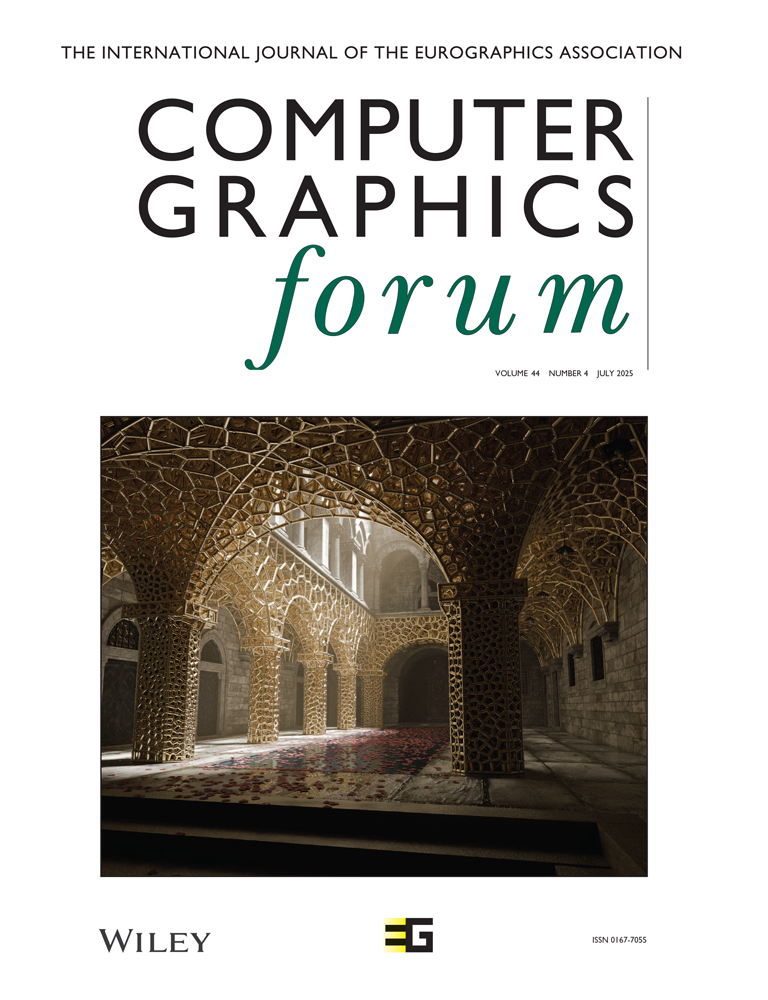Image Registration in a Coarse Three-Dimensional Virtual Environment
R. G. Laycock
School of Computing Sciences University of East Anglia Norwich, UK, [email protected] , [email protected]
Search for more papers by this authorA. M. Day
School of Computing Sciences University of East Anglia Norwich, UK, [email protected] , [email protected]
Search for more papers by this authorR. G. Laycock
School of Computing Sciences University of East Anglia Norwich, UK, [email protected] , [email protected]
Search for more papers by this authorA. M. Day
School of Computing Sciences University of East Anglia Norwich, UK, [email protected] , [email protected]
Search for more papers by this authorAbstract
In recent years, the availability of off-the-shelf geometric data for an urban environment has increased. During rendering, ground level images are mapped onto the façades of the buildings to improve the visual quality of the scene. This paper focuses on a technique that enables ground level images to be automatically integrated into an existing coarse three-dimensional environment. The approach utilises the planar nature of architectural scenes to enable the automatic extraction of a building façade from an image and its registration into the virtual environment.
References
- 1 C. Brenner and N. Haala. Fast production of virtual reality city models, In Proceedings of ISPRS Comm. IV Symposium, Stuttgart , September 7–10, IAPRS, 32(4), pp. 323–330, 1998.
- 2 C. Früh and A. Zakhor. Fast 3d model generation in urban environments, international conference on multisensor fusion and integration for intelligent systems. Baden-Baden , Germany , 165–170, August 2001.
- 3 O. Faugeras, L. Robert, S. Laveau, G. Csurka, C. Zeller, C. Gauclin and I. Zoghlami. 3-d reconstruction of urban scenes from image sequences. Computer Vision and Image Understanding, 69(3): 292–309, 1998.
- 4 A. Dick, P. Torr and R. Cipolla. Automatic 3d modeling of architecture, In Proceedings of 11th British Machine Vision Conference, Bristol , pp. 372–381, 2000.
- 5 D. Liebowitz, A. Criminisi and A. Zisserman. Creating architectural models from images. Computer Graphics Forum, 18(3): 39–50, 1999.
- 6 S. Gibson, R. J. Hubbold, J. Cook and T. L. Howard. Interactive reconstruction of virtual environments from video sequences. Computers and Graphics, 27(2), 2003.
- 7 P. Debevec, C. Taylor and J. Malik. Modelling and rendering architecture from photographs: A hybrid geometry- and image-based approach, In Proceedings of ACM Siggraph, pp. 11–20, 1996.
- 8 H. Zhao and R. Shibasaki. Reconstructing a textured CAD model of an urban environment using vehicle-borne laser range range scanners and line cameras. Machine Vision and Applications, 14: 35–41, 2003.
- 9 C. Rocchini, P. Cignoni and P. Scopigno. Multiple texture stitching and blending on 3d objects. In 10th Workshop on Rendering, Eurographics, Granada , Spain , 173–180, 1999.
- 10 T. Tipdecho. Automatic image registration between image and object spaces. In Proceedings of Open source GIS - GRASS users conference 2002, Trento , Italy , 2002.
- 11 H. Lensch, W. Heidrich and H. Seidel. Automated texture registration and stitching for real world models. Pacific Graphics, 317–327, 2000.
- 12 X. Wang, S. Totaro, F. Taillandier, A. Hanson and S. Teller. Recovering façade texture and microstructure from real world images. In proceedings of 2nd International workshop on Texture Analysis and Synthesis at ECCV, pp. 145–149, 2002.
- 13 C. Jaynes and M. Partington. Pose calibration using approximately planar urban structure. Asian Conference on Computer Vision, 1999.
- 14 I. Stamos and P. Allen. 3-D model construction using range and image data. In Proceedings of IEEE Conference on Computer Vision and Pattern Recognition, Hilton Head, S.C., 531–536, 2000.
- 15 S. C. Lee, R. Nevatia and S. K. Jung. Automatic integration of façade textures into 3d building models with a projective geometry based line clustering. Computer Graphics Forum, 21(3), 511–519, 2002.
- 16 S. Neumann, S. You, J. Hu, B. Jiang and J. W. Lee. Augmented virtual environments (AVE): Dynamic fusion of imagery and 3D Models, IEEE Virtual Reality 2003, Los Angeles California , 61–70, 2003.
- 17 R. G. Laycock and A. M. Day. Automatically generating large urban environments based on the footprint data of buildings. ACM Solid Modelling 2003, Seattle, 346–351, 2003.
- 18 F. Waack. http://www.stereoscopy.com/library/waack-ch-4.html, 2004.
- 19 J. Shi and C. Tomasi. Good features to track. In IEEE Conference on CVPR, 593–600, 1994.
- 20 J. F. Canny. A computational approach to edge detection, IEEE Transaction on Pattern Analysis and Machine Intelligence, 679–698, 1986.
- 21 N. Ayache and B. Faverjon. Efficient registration of stereo images by matching graph descriptions of edge segments. IJCV, 1(2): 107–131, 1987.
- 22 J. J. Guerrero and C. Sagüés. Robust line matching and estimate of homographies simultaneously. Pattern Recognition and Image Analysis, 2652/2003, 297–307, 2003.
- 23 K. Muhlmann, D. Maier, J. Hesser and R. Manner. Calculating dense disparity maps from colour stereo images, and efficient implementation. In IEEE Conference on Computer Vision and Pattern Recognition, Kauai Marriott , Hawaii , 30–31, 2001.
- 24 R. Hartley and A. Zisserman. Multiple view geometry in computer vision, Cambridge University Press, 2000, 0-521-62304-9.
- 25 M. A. Fischler and R. C. Bolles. Random sample consensus: A paradigm for model fitting with applications to image analysis and automated cartography. CACM, 24(6): 381–395, 1981.
- 26 D. Liebowitz and A. Zisserman. Metric rectification for perspective images of planes, In Proceedings of IEEE Conference on CVPR, Santa Barbara , California , pp. 482–488, 1998.
- 27 R. I. Hartley. In defense of the eight point algorithm, IEEE transactions on pattern analysis and machine intelligence, 19(6): 580–593, 1997.
- 28
A. Telea.
An inpainting technique based on the fast marching method.
Journal of Graphics Tools, 9(1), ACM Press, 25–36, 2004.
10.1080/10867651.2004.10487596 Google Scholar
- 29 R. G. Laycock and A. M. Day. Automatic techniques for texture mapping in virtual urban environments. Computer Graphics International 2004, 586–589, 2004.




